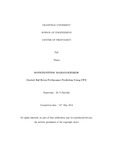JavaScript is disabled for your browser. Some features of this site may not work without it.
| dc.contributor.advisor | Pachidis, Vassilios | |
| dc.contributor.author | Karamolegkos, Konstantinos | |
| dc.date.accessioned | 2015-06-12T14:57:27Z | |
| dc.date.available | 2015-06-12T14:57:27Z | |
| dc.date.issued | 2014-05-12 | |
| dc.identifier.uri | http://dspace.lib.cranfield.ac.uk/handle/1826/9241 | |
| dc.description.abstract | Aviation industry has a crucial impact on society on the grounds that it offers wider social and economic benefits. The demand of transportation is increasing and it is expected that the worldwide fleet of aircraft and rotorcraft will increase accordingly. This growth will introduce an increased environmental impact which can be controlled with the introduction and the implementation of new and greener technologies which can provide both a reduced carbon foot-print and increased efficiency. Therefore, the simulation of new designs with tools that can capture the flow physics accurately is crucial, on the grounds that an accurate simulation could provide novel designs and new ways in order to design from scratch new vehicles as well as providing a better appreciation of the physics that are involved. This work has a central aim to propose a methodology which combines CFD simulations and the method of performance mapping. It focuses on the application of a ducted tail rotor which can offer significant performance benefits compared to a conventional tail rotor. The developed methodology was tested against the results of an in-house rotorcraft comprehensive code and provided a reasonable qualitative correlation. In principle, this methodology can work for all helicopter flight phases such as hover, climb, cruise, descend but due to the complexity of the investigations, together with the lack of experimental data that can be used to refine the CFD model, only the hover and forward flight were considered. Although CFD studies of a ducted tail rotor currently exist in the literature (though scarce), this work can be considered, to the best knowledge of the author as a first attempt in investigating the performance of the configuration, from low to high forward flight speed, by combining CFD and performance mapping. | en_UK |
| dc.language.iso | en | en_UK |
| dc.publisher | Cranfield University | en_UK |
| dc.rights | © Cranfield University 2014. All rights reserved. No part of this publication may be reproduced without the written permission of the copyright holder. | en_UK |
| dc.subject | Ducted tail rotor | en_UK |
| dc.subject | Conventional tail rotor | en_UK |
| dc.subject | Edgewise flow | en_UK |
| dc.subject | CFD | en_UK |
| dc.subject | Performance Mapping | en_UK |
| dc.title | Ducted Tail Rotor Perfomance Prediction Using CFD | en_UK |
| dc.type | Thesis or dissertation | en_UK |
| dc.type.qualificationlevel | Doctoral | en_UK |
| dc.type.qualificationname | PhD | en_UK |
